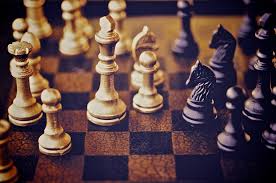Most scholars agree that chess originated in India during the first centuries of the Christian era with the name chaturanga, which translates as “four divisions (of the military),” today symbolized by the pawn, knight, bishop, and rook.
The game went to Persia, where the name became chatrang and they started calling shah (“king”) when attacking the opponent’s king, and shah mat (“the king is helpless”) when the king could not escape from an attack. The call became known worldwide, and today we say “check” and “check mate” in English.
But how did “chess” and “check” come into English? Arabs took up the game everywhere, including the calls, and the word shah entered Medieval Latin as scaccus . It went from here to Old French eschec, which meant both “game of chess” and “checkmate,” and its plural eschés (in Modern French, “chess” is échecs , in plural, while the singular word échec means “defeat”). As it happened with most English vocabulary, both Old French words entered Middle English: the plural eschés became “chess,” and the singular eschec became chek, chekke, and then “check.” While in most of Europe the name of the game came from shah, the Persian name chatrang, modified after the Islamic conquest of Persia as shatranj, went to North Africa, where the Moors turned it into shaterej. The word entered Spanish (ajedrez ), Portuguese (xadrez ), and Greek (zatrikion ).
What happened in Armenian? Here, of course, because of Persian influence, the route was much straightforward. The word chatrang became ճատրակ (chatrak in Classical Armenian), and this is how we call it in Western Armenian (pronounced jadrag) to this day. Interestingly, St. Krikor Datevatsi (fifteenth century) had the word սատրիճ (satrij), which was derived from Arabic shatranj, but this did not enter the literary language and remained in some dialects as satrinj .
Armenians have revealed themselves, as we know, brilliant chess players since the twentieth century. Suffice it to mention the names of Tigran Petrosian and Garry Kasparov. It is an intriguing fact that the name of the game in Eastern Armenian went on a completely different road. A Russian-Eastern Armenian dictionary published in Tiflis (1876) listed jadrag and satrinj as translation for the Russian word shakhmat (“chess game,” which also means “chessboard”) , which was a borrowing from German Schachmatt (“checkmate”). However, it appears that in the twentieth century the loanword from Russian շախմատ ( shakhmat “chess game”) totally overtook jadrag, becoming the term of choice in Eastern Armenian to this day. Even if Armenian modern dictionaries list jadrag and shakhmat as synonyms, Western Armenians consider jadrag an authentic Armenian word and shakhmat a loanword, which is not far from the truth, since the former, despite being also a foreign word, entered the Armenian language a thousand years ago or so.

